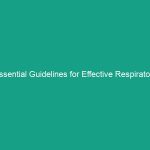Introduction
Good morning team! Today, we’re going to discuss an exciting and essential topic: the essential guidelines for successful renewable energy adoption in Health, Safety, and Environment (HSE). As we shift towards renewable energy sources, it is crucial to understand how this transition impacts our Workplace Safety and practices. This topic is not just relevant; it’s vital for ensuring a safe and productive work environment as we navigate new technologies and methods. Let’s dive into why these guidelines are important for your daily operations and how they can help prevent accidents and enhance our overall Safety culture.
Understanding Essential Guidelines for Successful Renewable Energy Adoption in HSE
The essential guidelines for successful renewable energy adoption in HSE refer to a set of practices designed to integrate renewable energy technologies into our operations while prioritizing Safety and environmental protection. These guidelines help mitigate risks associated with renewable energy projects, such as solar panel installation or wind turbine Operation.
It’s essential to recognize that while renewable energy offers numerous Benefits, including reduced carbon emissions and long-term cost savings, it also introduces unique challenges. Misconceptions often arise, such as the belief that renewable energy is inherently safe. However, like any other energy source, it presents specific Hazards that we must address to safeguard our employees and the environment.
Key Hazards, Risks, and Safety Considerations
As we adopt renewable energy technologies, we must be aware of the specific hazards and risks they pose. Here are some key concerns to consider:
- Electrical Hazards: Working with solar panels and wind turbines involves high voltages. Proper Training and Safety Measures are essential to prevent electrical shocks and injuries.
- Working at Heights: Installation and Maintenance of renewable energy systems often require working at heights, which increases the risk of falls. Fall protection equipment and protocols must be strictly followed.
- Chemical Exposure: Some renewable technologies, such as batteries for energy storage, may involve hazardous materials. Understanding Material Safety Data Sheets (MSDS) and proper handling techniques is crucial.
- Environmental Risks: While renewable energy is generally more environmentally friendly, improper installation or operation can lead to habitat disruption and pollution.
Ignoring these risks can lead to severe consequences, including workplace injuries, legal liabilities, and damage to our reputation. Therefore, it’s essential to remain vigilant and proactive in identifying and mitigating these hazards.
Best Practices, Procedures, & Actionable Advice
Now that we understand the hazards, let’s look at some Best Practices and Procedures to ensure safe renewable energy adoption:
1. Comprehensive Training
Ensure that all employees involved in renewable energy projects receive thorough training. This should cover:
- Understanding the technology and its associated hazards.
- Proper use of Personal Protective Equipment (PPE).
- Emergency response procedures in case of accidents.
2. Risk Assessments
Conduct regular risk assessments before starting any renewable energy project. This should include:
- Identifying potential hazards.
- Evaluating the likelihood and severity of risks.
- Implementing Control Measures to mitigate identified risks.
3. Safety Protocols
Develop and enforce safety protocols tailored to renewable energy projects. These should include:
- Lockout/tagout procedures for electrical systems.
- Fall protection measures for working at heights.
- Proper storage and handling procedures for hazardous materials.
4. Case Studies
Let’s look at a brief example to illustrate the importance of these guidelines. In 2022, a solar panel installation company failed to conduct a proper risk assessment. As a result, an employee suffered electrical shock due to inadequate Safety Measures. This incident not only resulted in serious injury but also led to significant financial losses for the company due to fines and legal fees. By adhering to essential guidelines, this situation could have been prevented.
Regulations, Standards, and Compliance
Compliance with Regulations and safety Standards is a critical aspect of renewable energy adoption. Below are a few relevant standards and regulations to consider:
- OSHA Standards: The Occupational Safety and Health Administration (osha) provides guidelines for Workplace Safety, including specific regulations for Electrical Safety and Fall Protection.
- ISO Standards: The International Organization for Standardization (ISO) has developed standards related to environmental management (ISO 14001) and Occupational Health and safety (ISO 45001).
- Company-Specific Policies: Always align with your organization’s safety policies and procedures, which may be more stringent than national regulations.
Understanding and adhering to these regulations is not just about compliance; it’s about creating a safe environment for everyone. Non-compliance can lead to severe penalties and a tarnished reputation.
Employee Engagement & Discussion
Now, let’s open the floor for discussion. I’d like to hear your thoughts on the following questions:
- What safety challenges have you encountered related to renewable energy?
- How can we improve our training programs to better address these challenges?
- What other safety measures do you think we should implement?
Your insights are invaluable in shaping our safety practices and ensuring we are all on the same page when it comes to renewable energy adoption.
Conclusion & Key Takeaways
In conclusion, the essential guidelines for successful renewable energy adoption in HSE are critical for maintaining a safe and productive workplace. By understanding the risks, implementing Best Practices, and complying with regulations, we can harness the benefits of renewable energy while ensuring the safety of our employees and the environment.
Remember, prioritizing safety is not just a responsibility; it’s a commitment we make to ourselves and each other. Thank you for your attention and your dedication to creating a safe work environment. Let’s continue to work together to prioritize safety in all our endeavors!


